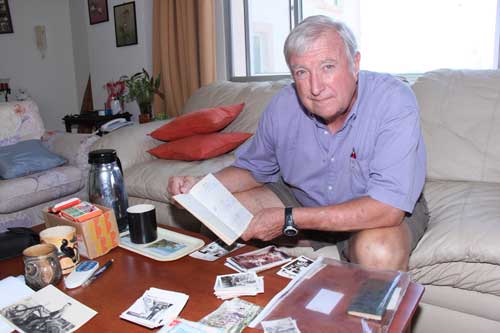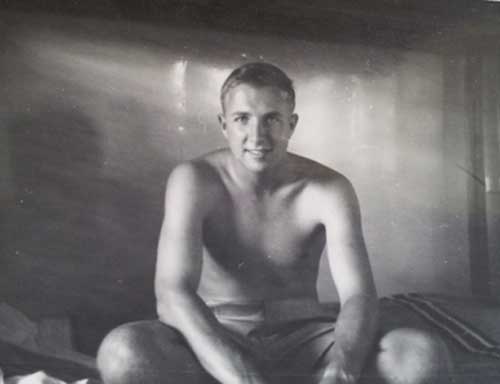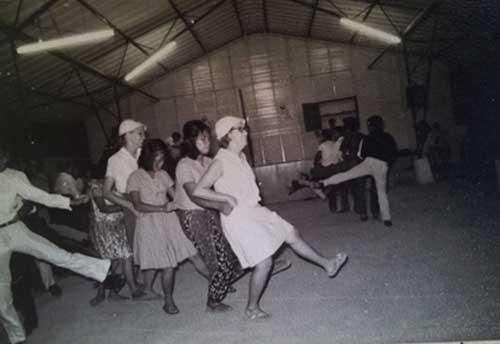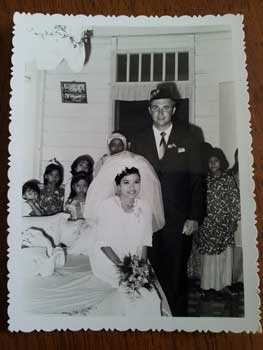
FLASHBACK AND MEMORIES: Richard Harvey going through some of the letters, photos and diary of his days as a Peace Corps volunteer.
TOWARDS the end of 1964, Richard Harvey who was then a second-year university student learnt about Peace Corps when the recruiters went to campus.
The 20-year-old Californian lad – dashing, lively, curious and adventurous – blindly filled up the form and turned it in.
In the form, he was given the option to choose a preferred destination which he answered ‘the further away, the better’.
“I wanted to travel. I’d never left home except travelling to a few states outside of California,” he giggled.
Few months later, a big letter came in the mail inviting him to join the programme in Asia, which he had no idea which part of the world that was.
“I’d never heard about Asia. I had to look it up in a map.”
The letter, which Richard said was possibly written by a Hollywood scriptwriter elaborated with decorative details of Sarawak, managed to lead him into temptation.
“I remember, there were descriptions like jungles and crocodiles. I was like ‘WOW… that should be exciting’. Unfortunately, the letter is now gone.”
Without hesitation Richard deferred his study and with his family’s support, he took the plunge.
And so he was sent all the way across to the other side of the globe, about 10,000 miles away from home – to the land of hornbills and headhunters with strange and challenging language -Sarawak!
The very first exotic escape
Sometime in 1965, Richard arrived in Kuala Lumpur and from there he was sent to Kuching where he had further training with about 50 other volunteers.
Richard was assigned to Sarikei where he spent two years there.
He had to find his own way there. At that time, there was no road to the town.
“Everything was by ship. There were two main ones – Pulau Kidjang and Rajah Mas. We booked the deck passage on the Kidjang because we did not have much money, only some allowance.”
In Sarikei, he worked with the agriculture office to help the local community, especially youths, improve their livelihood through farming.
Equipped only with the very basic of Malay, there was no problem communicating with the people (or so he thought).
The problem was while he could make himself understood with his ‘official Bahasa Kebangsaan’ the challenge was the replies from the locals who spoke in colloquial Malay.
“They could understand us, but it was a bit difficult trying to understand them.
“Also, a lot of people spoke English back then. But, we wanted to speak Malay because we wanted to improve our Malay.
“When we spoke to people in Malay, they would respond in English. So that did not help us learn more or improve our Malay. But we definitely could get by.”
Volunteers and natives shared and exchanged technical knowledge on farming through the Fun Youth Club, also known as the 4H Club, which they were setting up.
“We set up the club here (Sarikei). Then, we would visit longhouses and schools to explain about the club and its programme. There, we would find out who were interested to join the club.”
Members of the club would decide on what projects they wanted to carry out, for instance raise chickens, plant vegetables or rear fish in ponds.
One of the Peace Corps’ major contributions, Richard said, was in vegetables farming where they experimented with the seeds brought in from the States.
“I learnt more from the locals than what I taught them because they were already very good at what they were doing.”
Other than farming, part of the activities also involved community development focussing on health and cleanliness.
“It was a rounded programme with a combination of activities. At first, it was aimed at the youth but anytime you did anything, the whole longhouse would come out.”
“Everyone was learning and participating so it was very effective.”
It was so exciting, fun and fascinating that young Richard was not homesick at all.
When asked if he had ever called home, he laughed and said: “Making a phone call at that time was a major thing. I never did call home.”
In those days, making a phone call was not a pleasant and simple five second ‘pick and dial without even having to look at the keypad’ sort of thing.
“You have to go to the telephone office and book your call. Tell them the destination you want to call. And they will tell you to come back at a certain time and try to connect you.”
So everything was by letter, in plain sheets of paper with matching envelopes or fold-and-mail with matching seals.
Richard’s mother kept all the letters, those memories that were written in handwriting that never fade until this day.
“And later, I bought a tape recorder to record voice messages and mail them home,” he said laughing, adding that it was the state-of-the-art communication back then.
The love story
During his time in Sarikei, Richard met Habibah at the hospital while visiting a friend and fell in love with her.
Habibah was attached with the hospital for nursing training.
After completing his two-year service in Sarikei, Richard went back to California.
“We were very close already when I left. But we didn’t tie the knot because we were still young.
“I had to finish my degree while she had to complete her nursing training.”
They kept in touch for a while but somehow lost contact.
“But I did not forget about her.”
Back in California, Richard went back to school for a little while before he was due for his military service. That was during the Vietnam War in 1968.
He was against fighting the war and his experience in Peace Corps did not exempt him from military service.
So he was required to do something as an alternative service for the country and opted for community servicing and was sent to Laos, working in agriculture.
In the middle of that two-year service, Richard had a leave.
“I’ve never forgotten about Habibah so I came back to Sarawak to look for her. I did not know what the situation was like then, whether she was married or had left Sarikei.”
Casting his fate to the wind, Richard bravely stepped into the old nurses house and asked for Habibah.
“Someone went to inform her and when she came out and saw me, she was quite surprised.”
They had not seen each other for a couple of years.
“The spark was still there,” Richard said cheekily.
After the short visit, he went back to Laos to finish his time and returned to Sarawak.
This time, he came back to ask for her hand in marriage.
“She was just near the end of her nursing training. So I stuck around until she agreed to marry me. She wasn’t too sure at first because she had plans for her life too.”
“Also, I stayed around to convince Habibah’s parents that we should get married.”
Richard then persuaded his parents to travel to Sarawak and hinted that they might meet his ‘future wife’.
His family, who at first refused the invitation, agreed to fly in.
“Finally, my parents met Habibah and her family. That was good because it showed that I am genuine and serious about marrying Habibah, not coming here to get a second wife.”
The big wedding ceremony was held in Sarikei in 1970 which the whole village attended.
After the wedding, Richard brought Habibah back to the States as he had to complete his education which had been deferred twice.
He finally did with a post-graduate degree and later a Master’s degree.
Habibah spent another year in college to get her nursing qualification and worked as a nurse until her retirement recently.
They also spent eight years in Singapore when Richard joined an American company.
They have a son who is now living in San Francisco.
Retirement
About four years ago, during their visit to Sarawak, Habibah’s relatives convinced them to stay back permanently.
For the past 40 years, the couple had lived in the States and occasionally made trips back whenever time and circumstances permitted so that Habibah could see her
family.
“She never left Sarawak before, never separated from her family when I brought her to the States. So it was a big thing for her. I understand that. So we try to come back once every three to four years.”
And so they moved back to Sarawak.
“I set up a business here earlier on but that did not go well. But I learnt some new things.
“I’d also worked for an engineering company for a few years. I’ve done a lot of things in life as I am very flexible.”
Now everything has settled down.
The 63-year-old Richard now spend his time hash running, jungle trekking, travelling and visiting old friends in the longhouses, takes long leisure rides on his scooter as well as fixing and building things.
“There is always something to do and more things to learn. I love the jungles and had always loved motorbikes. Kuching is a wonderful place to live in.”




